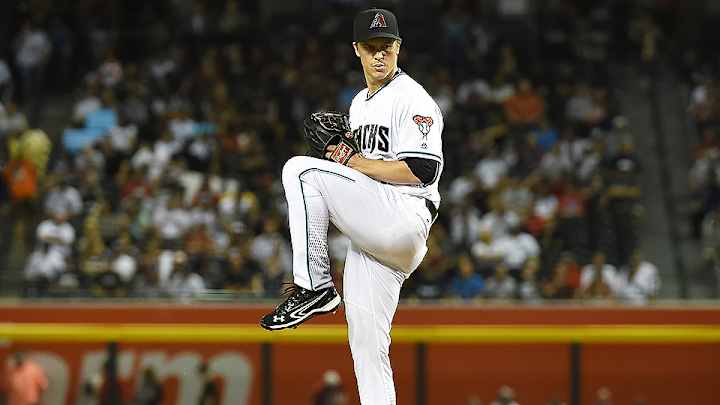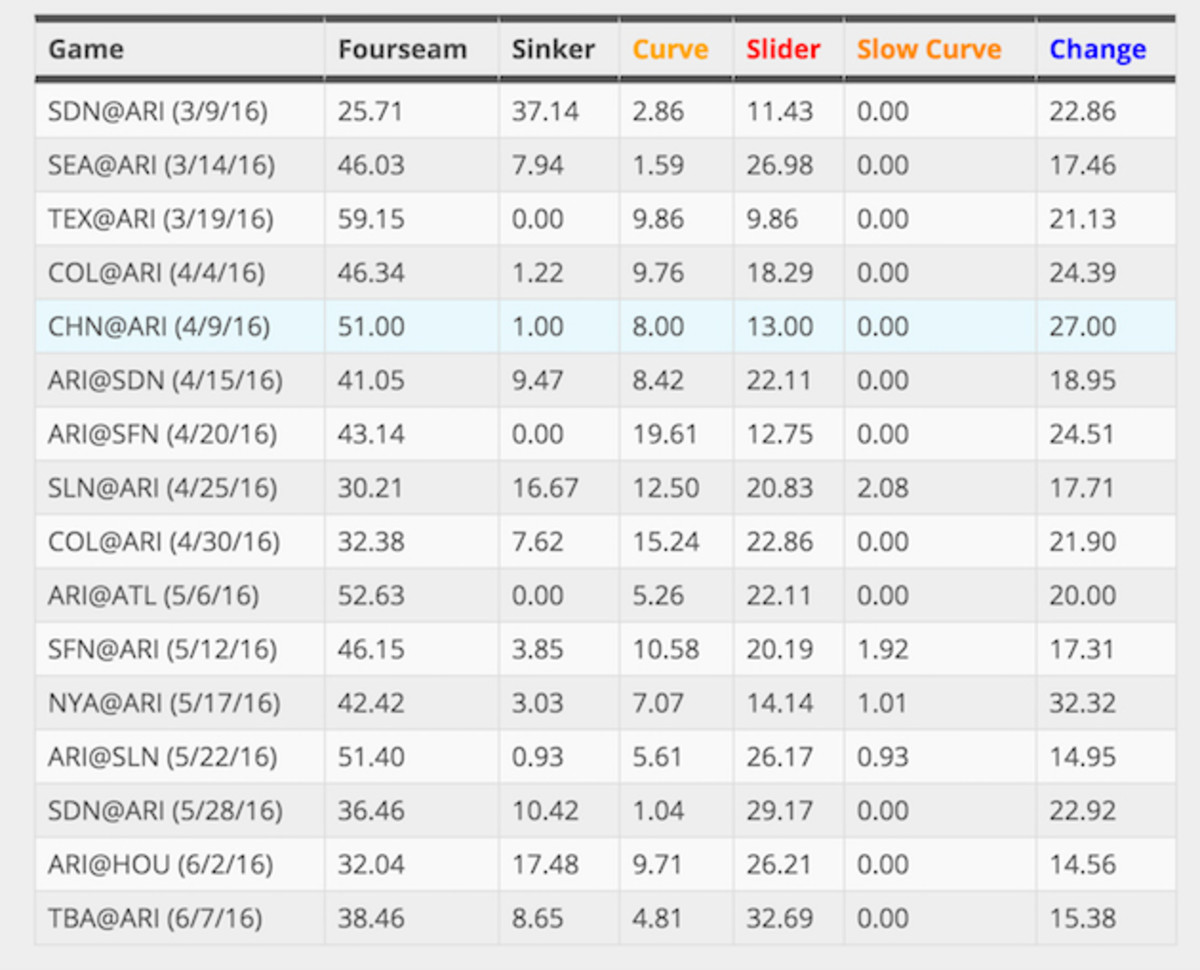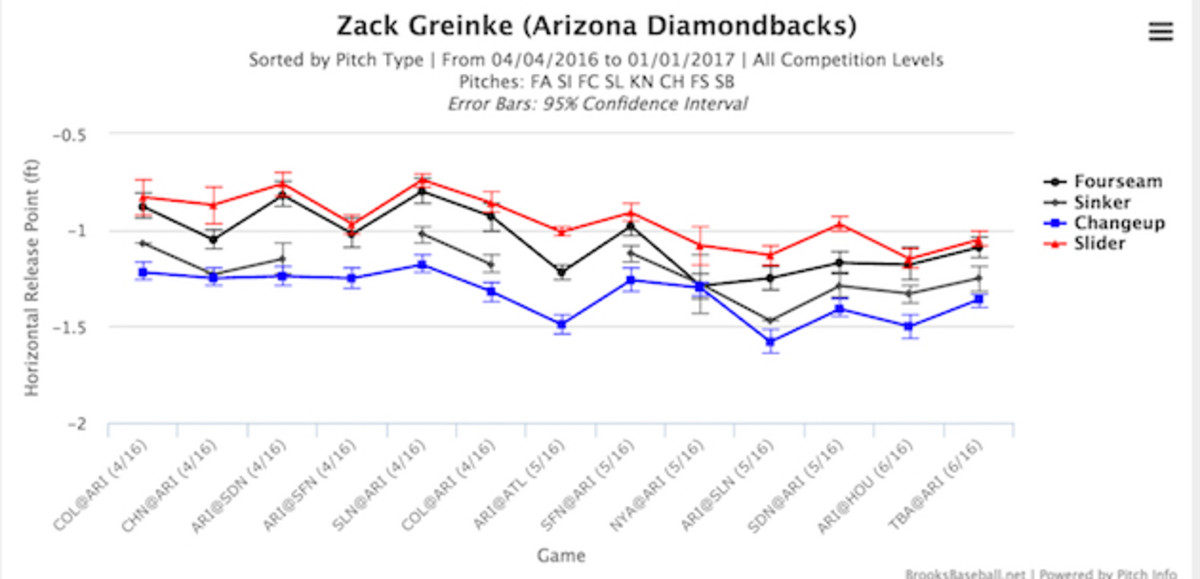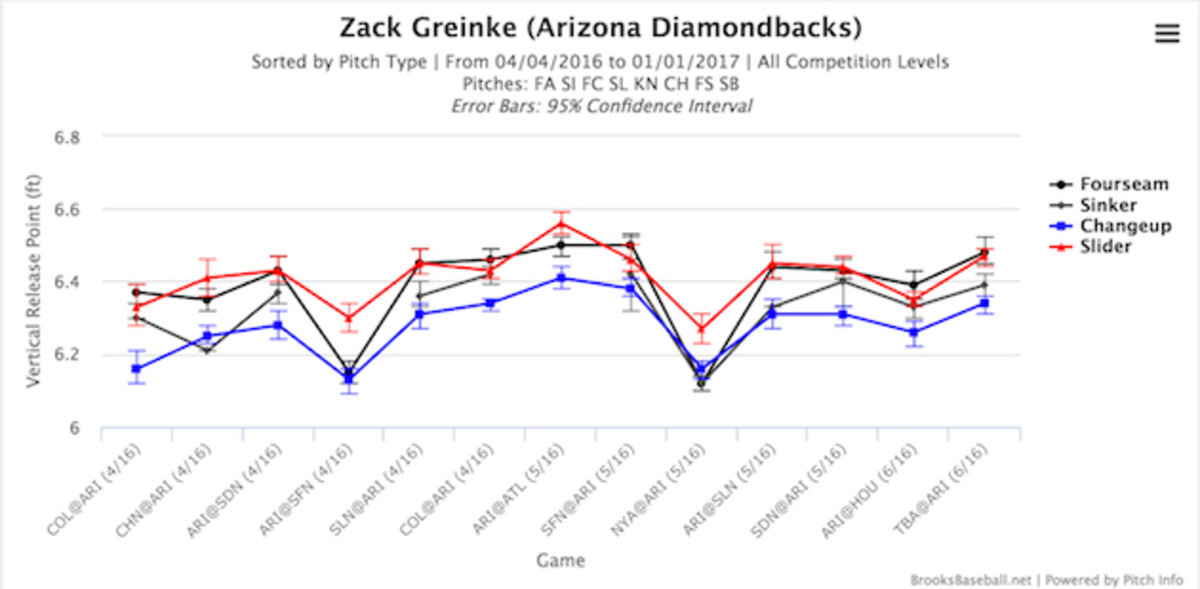Pitching report: Zack Greinke quickly recovering from slow start to 2016

Three of last year’s fantasy aces stumbled out of the gates this season. Chris Archer and Dallas Keuchel have continued to struggle, but Zack Greinke has mostly turned things around—though it remains masked by his season-long numbers.
Greinke finished April with a 5.50 ERA and 1.46 WHIP, but in his last start of the month, Greinke limited the Rockies to two runs on eight hits, striking out eight while walking two across seven innings. He may not have earned the win, but it was his best start of the season to date, and may serve as his turning point when we give the entire season a post mortem.
Greinke had a solid May, posting a 3.82 ERA, 3.54 FIP and 1.12 WHIP in 33 innings. His strikeout rate increased, his walk rate decreased and his slash line against dipped to .246/.285/.398 from .298/.335/.523 in the previous month. He did have one shutdown outing against the imposing Cardinals in St. Louis, allowing one run on five hits with seven strikeouts in eight innings. It was the first time this season that he finished the eighth inning.
Fantasy baseball Waiver Wire: It’s time to add Trayce Thompson
In two June starts, Greinke has resembled the pitcher who had the best ERA in the majors last year and nearly won the NL Cy Young Award. He hasn’t allowed a run while letting just nine men reach base in 16 innings. He fanned 11 batters in seven innings in a win over the Astros, and followed that up with a shutout of the Rays in which not one runner reached second base. The Rays had three hits and two walks in the game. All but one of those reached base with two outs and nobody on.
To be fair, Greinke really hasn’t pitched as bad as his cosmetic stats would suggest, even going back to his disastrous April. His ugly numbers coming out of the first three months of the season owed largely to bad outings against the Rockies, Cubs and Cardinals, three of the best offenses in baseball. He gave up 18 runs on 27 hits, including five homers, in 16 2/3 innings in those starts. Even so, his FIP for the month was 3.78, better than the season-long FIPs of Marco Estrada, Max Scherzer and Julio Teheran, three pitchers many fantasy owners would likely assume are having better seasons than Greinke.
Still, there’s no question that Greinke has been better recently than he was in April, even if his overall numbers that month didn’t match up with his underlying stats. The easiest, and first, thing to do whenever a pitcher’s performance changes noticeably in the middle of the season is to see if he’s doing anything differently. In Greinke’s case, we find a few changes worth discussing. All charts and graphs are courtesy of Brooks Baseball. The one below shows the usage rate for all of Greinke’s pitches, by start.

Greinke has dramatically increased the usage rate on his slider. Over his first five starts of the season, which cover Opening Day through his last ugly April start, he threw the slider 17.3% of the time. Since then, 24.2% of Greinke’s pitches have been sliders. In fact, his four highest single game usage rates for the slider rates have come in his last four starts, with the highest being his most recent time out when he shut out the Rays.
Hitters roughed up Greinke when they saw the fastball in April, but then, to be fair to that pitch, they got to him no matter what he threw. Over Greinke’s first five starts of the season, he allowed a .367 batting average and .674 slugging percentage—good for a .306 ISO—on the fastball. His other pitches weren’t much better, but the greater issue there is all the volume. You can get away with allowing a .500 batting average and .875 slugging percentage on a pitch, as Greinke did with his sinker in those same five starts, when you only throw it 27 times. When you’re letting hitters hit .367 and slug .674 against a pitch you’re throwing 42.3% of the time, you’re going to have problems.
The fastball has been nearly as bad since, with hitters racking up a .307 batting average and .548 slugging percentage. He has really turned things around, however, on the strength of his slider. Opposing batters are hitting just .123 with a .154 slugging percentage against the pitch. In 65 at-bats where the slider was the final pitch, they have eight hits, just two of which have gone for extra bases (both doubles), and 28 strikeouts.
The 30: Defense saves (or sinks) in this week's MLB power rankings
In the first month of the season, Greinke was also too hittable with two strikes. He allowed a .250 batting average in two-strike counts, with six of the 14 hits he surrendered going for extra bases. You probably guessed this, but the fastball was the main culprit. Hitters went 6-for-17 with a homer, two doubles and a triple against the fastball in two-strike counts. The slider, however, was dominant, with hitters going 2-for-12 with zero extra-base hits and six strikeouts. For some reason, though, Greinke threw the fastball 35.9% of the time in two-strike counts, while he offered the slider just 20.6% of the time.
Greinke was surprisingly resistant to use the slider as a put-away pitch. In 1–2 counts, typically a great time to go with a breaking ball especially one as good as Greinke’s slider, he threw 21 fastballs and seven sliders. In 2–2 counts, it was 12 fastballs and 10 sliders. At 3–2, he threw six fastballs and just one slider.
Greinke has flipped all of those rates, and then some, since the end of April. Let’s start with the overall picture. When he has gotten to two strikes, he has turned to his slider for 45.8% of his pitches compared with a 21.7% usage rate for his fastball. Unsurprisingly, he has limited hitters to a .061 batting average in those counts (3-for-49) with the aforementioned 28 strikeouts. At the same time, likely because they’re looking for the slider, hitters have gone 2-for-20 with 10 strikeouts against the fastball in two-strike counts.
Pitching 101 says when you get to 0–2 on a hitter, you bust him high and tight with a fastball, which sets him up for a breaking ball low and away. Greinke hasn’t followed that script in May and June, throwing 10 fastballs and 27 sliders in 0–2 counts. He has ended 14 at-bats with his 0–2 pitch, with hitters going 0-for-14 with eight strikeouts. By comparison, hitters were 3-for-11 against Greinke in 0–2 counts in April.
In 1–2 counts, Greinke has been similarly reliant on the slider. The fastball gains ground on 2–2 and 3–2, but the slider has still earned a plurality, even after bringing his change and sinker into the mix.
Greinke’s other two changes are more closely related. Thanks to Brooks Baseball’s charting of horizontal and vertical release points, we can safely say that Greinke has been more consistent with his arm slot, beginning with his last April start.
The first chart below represents Greinke’s horizontal release point by start, while the second one is his vertical release point. We’ve removed the curveball, which Greinke throws sparingly, to make the charts easier to read.


Greinke has been repeating the same release point, regardless of pitch, much more recently. That’s absolutely necessary for a pitcher to be deceptive. It would seem a minuscule thing to you or me, but major league hitters can pick up on release points that are different by fractions of an inch.
As an example, take a look at the wide gaps in his release points, especially the horizontal, for his April start against the Cardinals. Greinke allowed seven runs on 11 hits, including two homers, in 6 2/3 innings in that start. It’s almost certain the Cardinals were able to pick up on the differences in those release points, meaning Greinke was effectively tipping his pitches.
Compare that with his most recent starts. The range of release points, both horizontal and vertical, has slimmed considerably. That the fastball and slider have been identically on the horizontal plane in his last two starts, and the vertical one his last four, makes Greinke particularly deceptive. Unless a hitter can identify the spin immediately he’s going to have no chance, outside of simply guessing correctly.
Greinke’s April was bad, but not nearly as terrible as his ERA and WHIP suggested. His luck has turned, both in terms of balls in play and the schedule, and he has made a few crucial tweaks to reduce hard contact and get more whiffs. The buy-low window may have slammed shut after his last two outings, too. All may not be well in Arizona, but Greinke has righted the ship.
Pitchers to watch this week
John Lackey, Cubs
The Cubs were certain they were getting a steady, playoff-tested arm for the middle of their rotation when they signed Lackey this offseason, but they couldn’t have expected anything like this. Based purely on performance to this point of the season Lackey has been, without hyperbole, one of the best pitchers in baseball. He has a 2.63 ERA, 2.99 FIP, 0.93 WHIP and 84 strikeouts in 82 innings. In standard 5x5 leagues, he’s the ninth-ranked starting pitcher, which is only good enough to make him the third best in his own rotation (behind Jake Arrieta and Jon Lester). From a fantasy perspective, there’s nowhere for Lackey to go but down, but don’t assume a major dropoff is on the horizon. Everything he has accomplished this season is on a solid foundation. He gets just one start this week, opposing the Nationals on Tuesday.
The good (and bad) of Pirates SP Jameson Taillon’s promising debut
Carlos Rodon, White Sox
The White Sox skipped Rodon’s last turn in the rotation due to nagging neck and arm issues, but he’s scheduled to take the ball against the Tigers on Tuesday. Rodon struggled in his most recent outing, which was also against the Tigers, but he was quite good in the three that led up to that. He only got one win in those starts—two against the Royals and one against the Astros—but allowed just five runs while fanning 14 batters and walking five in 17 2/3 innings. Keep an eye on Rodon’s velocity in his first few innings. If that’s where it is supposed to be, we can likely put any fears of a serious injury to rest.
Max Scherzer, Nationals
Scherzer’s still giving up too many homers, but if that’s the price his owners have to pay to get the rest of his numbers, they’ll gladly fork it over. Over the last 30 days, only four starting pitchers—Clayton Kershaw, Jose Fernandez, Madison Bumgarner and Lackey—have outperformed Scherzer in standard 5x5 leagues. In that time, he has a 2.58 ERA, 0.84 WHIP and 61 strikeouts in 45 1/3 innings. It’s not just the 20-strikeout game doing all the work, either. In his five starts since entering the record books, Scherzer has 41 whiffs in 36 1/3 innings. His 30.5% strikeout rate is fifth highest in the majors. Scherzer will next take the mound on Monday against the Cubs, who touched him up for seven runs on seven hits, including four homers, in five innings the last time they met. He’ll get a second start against the Padres over the weekend.
Picking winners and losers from MLB draft's first round
Sonny Gray, A’s
Gray made his second start on Friday since returning from the DL, and while he took the loss, it was arguably his best outing of the season. Gray limited the Reds to two runs on five hits in 7 2/3 innings, striking out four and walking one. In 12 2/3 innings since returning from the DL, Gray has surrendered three runs and allowed just fewer than one baserunner per inning while fanning nine batters. Gray really struggled over the first two months of the season, but these last two starts should encourage his owners. He’ll make his next start Wednesday against the Rangers.
Jeff Locke, Pirates
Why is a pitcher like Locke, who’s owned in fewer than 10% of fantasy leagues, a pitcher to watch? After getting roughed up by the Rockies on Thursday, his hold on a rotation spot is as tenuous as it has been all season. The Pirates may have sent Jameson Taillon back to the minors after his first start, but that’s a short-term move they can get away with thanks to Monday being an off day. Taillon will be back in short order, and fellow prospect Tyler Glasnow might not be far behind him. It’s likely that Juan Nicasio would be the first Pittsburgh starter to move to the bullpen for good, but Glasnow has been every bit as good as Taillon at Triple A Indianapolis this season. If the team’s brain trust decides his time is also now, it’s Locke who would be out of a starting job. He could hasten Glasnow’s arrival depending on what he does against the Mets on Wednesday.
Prospect watch
Josh Hader, Brewers
When Hader took the mound for his 11th start of the season last Monday, he still had yet to eclipse 90 pitches in an outing. He threw 103 across six innings of one-run ball that night, striking out eight and walking two. In retrospect, the increased workload should have been a sign that the Milwaukee organization believed Hader was ready to take the next step in his development. Two days later, the team announced that the 22-year-old would advance to Triple A Colorado Springs, where he made his first start on Sunday.
What you should know about Yulieski Gourriel, latest Cuban MLB hopeful
Hader was named a Southern League All-Star after racking up a 0.95 ERA, 1.00 WHIP and 73 strikeouts in 57 innings with Double A Biloxi. There were some questions coming into the season regarding whether or not Hader would be able to stick in a major league rotation, or if he’d eventually have to move to the bullpen. He has done well to answer some of those thus far in 2016, but the Brewers will want to see more of the same from him at the highest level of the minors before they trust him in their major league rotation. The questions largely surrounded his changeup, which has been little more than a show pitch for the left-hander. Righties might be able to get away with that, but lefties really need a changeup that’s at least good enough to force right-handed batters to respect it, even if they don’t fear it. Hader is still working on the offering. The good news is that he has cut down on his control issues, walking 19 batters at Biloxi. That’s still too many on a per-inning basis, but is much better than the walk rates he has posted in the past. The Brewers may not be going anywhere this season, but that doesn’t mean we will surely see Hader in the majors early enough for him to make a fantasy impact.
GIF of the week
It has been a while since we last checked in on Kenta Maeda’s rookie season. Let’s do that now, with some help from Carlos Gonzalez.
Three strikeouts, with three different pitches to end the at-bat. I’d say things are going pretty well, that is, unless you’re Gonzalez.
Two-start pitchers
- Max Scherzer
- David Price
- Jacob deGrom
- Carlos Carrasco
- Drew Pomeranz
- Zack Greinke
- Kyle Hendricks
- Julio Teheran
- Jordan Zimmermann
- Kenta Maeda
- Chris Tillman
- Taijuan Walker
- Gio Gonzalez
- Nathan Eovaldi
- R.A. Dickey
- Marcus Stroman
- Jimmy Nelson
- Ervin Santana
- Jerad Eickhoff
- Edinson Volquez
- Wei-yin Chen
- Juan Nicasio
- Brandon Finnegan
- Sean Manaea
- Chase Anderson
- Martin Perez
- Chad Bettis
- Matt Boyd
- Colin Rea
- Mike Bolsinger
- Albert Suarez
- Aaron Blair
- Ricky Nolasco
- James Shields
- Jered Weaver
- Alfredo Simon
